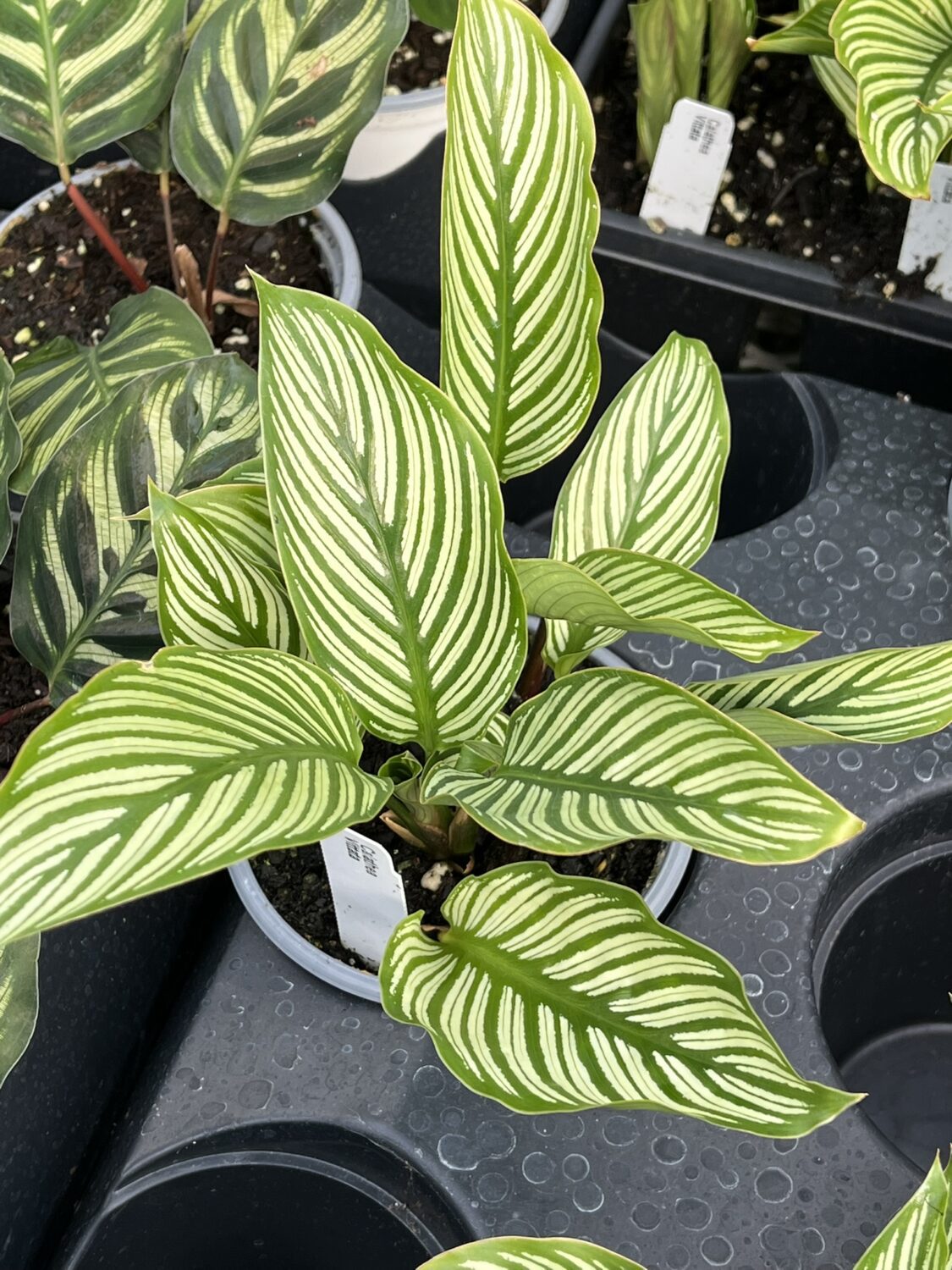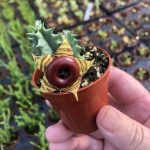Calathea vittata
Price range: $9.99 through $19.99
Hardiness Zone 9+
Discount per quantity
| Quantity | 3 - 8 | 9 - 14 | 15+ |
|---|---|---|---|
| Price | Price range: $9.69 through $19.39 | Price range: $9.39 through $18.79 | Price range: $8.99 through $17.99 |
| % Discount | 3% | 6% | 10% |
Description
Calathea vittata: How to Grow and Care for This Elegant Houseplant
If you’ve been looking for a houseplant that’s subtle yet stunning, Calathea vittata is a perfect choice. Its slim, lance-shaped leaves are painted with soft green and creamy white stripes. This pattern is simple yet sophisticated, bringing calm beauty to any corner of your home.
Even better? This tropical charmer is non-toxic to pets and children and helps clean the air. It’s a safe, stylish way to bring nature indoors.
Let’s explore how to grow and care for Calathea vittata so it thrives in your home.
Meet Calathea vittata
Native to South America’s lush rainforests, Calathea vittata is part of the Marantaceae family—often called prayer plants. At night, its leaves gently fold upward, almost like hands in prayer. This daily movement adds an extra layer of life to your indoor garden.
Unlike some Calatheas with bold purples or deep pinks, Vittata’s beauty is more refined. Its light green leaves, lined with creamy white veins, look timeless and elegant. This makes it perfect for minimalist or natural home styles.
Why Choose This Plant?
-
Compact Size – Perfect for shelves, desks, and small tables.
-
Pet-Friendly – Safe for cats, dogs, and curious little hands.
-
Air-Purifying – Helps filter indoor air and improve your home’s atmosphere.
-
Low to Medium Light Friendly – Thrives even in spaces without bright sun.
Growing Calathea vittata
Caring for Calathea vittata means mimicking its rainforest home. Warmth, humidity, and soft light are key. Let’s break it down step by step.
1. Planting and Propagation
Calathea vittata grows in small clumps that are easy to divide. This makes propagation straightforward.
How to Propagate:
-
Gently remove the plant from its pot.
-
Separate natural clumps, ensuring each has roots and leaves.
-
Plant divisions in fresh, well-draining soil.
-
Water lightly and place in bright, indirect light.
Spring or summer is the best time to divide, as the plant is actively growing.
2. Light Requirements
This plant loves bright but indirect light. Direct sun can scorch its delicate leaves and fade the striping.
Best Locations:
-
Near east- or north-facing windows.
-
Behind sheer curtains in brighter rooms.
-
Outdoors in shaded spots (summer only).
Low light is tolerated but may slow growth.
3. Soil Mix
Calathea vittata needs soil that stays moist but never soggy.
Ideal Mix:
-
2 parts potting soil
-
1 part peat moss or coconut coir
-
1 part perlite or coarse sand
This blend keeps roots aerated while holding just enough water.
4. Watering
Moisture is crucial, but overwatering is risky. Aim for balance.
Watering Tips:
-
Water when the top inch of soil feels dry.
-
Use filtered or distilled water (Calatheas dislike fluoride and chlorine).
-
Keep soil evenly moist in spring and summer.
-
Water less in fall and winter when growth slows.
Watch for Signs:
-
Yellow leaves = too much water.
-
Brown tips = too little water or low humidity.
5. Temperature and Humidity
Think rainforest: warm and humid.
-
Temperature: 65–80°F (18–27°C)
-
Humidity: 50% or higher
Use a humidifier, mist regularly, or set the pot on a pebble tray with water. Keep away from cold drafts or heating vents.
6. Fertilizing
Feed during active growth for lush foliage.
-
Use a balanced, water-soluble fertilizer at half strength.
-
Apply every 4–6 weeks in spring and summer.
-
Pause feeding in fall and winter.
Flush soil every few months to prevent salt buildup from fertilizer.
7. Pruning and Cleaning
Pruning keeps the plant tidy and encourages new growth.
-
Trim yellow or brown leaves at the base.
-
Wipe leaves with a damp cloth to remove dust.
-
Rotate the plant every few weeks for even growth.
8. Pests and Problems
Calatheas can attract spider mites, aphids, or mealybugs—especially in dry air.
Prevention & Treatment:
-
Inspect leaves often for pests or sticky residue.
-
Wipe affected leaves with mild soapy water.
-
Use neem oil or insecticidal soap for larger infestations.
-
Avoid soggy soil to prevent root rot.
9. Repotting
Repot every 1–2 years or when roots fill the pot.
Repotting Steps:
-
Choose a pot 1–2 inches wider than the current one.
-
Gently remove and inspect roots, trimming any damaged areas.
-
Refresh with new soil and water lightly.
-
Keep in indirect light and high humidity while it settles.
10. Special Tips for Success
-
Rotate weekly to prevent leaning toward light.
-
Group with other tropical plants to boost humidity naturally.
-
Use decorative planters to highlight Vittata’s striped foliage.
-
Be patient—new leaves often emerge rolled up and unfurl slowly.
Common Issues and Fixes
-
Brown Leaf Edges: Low humidity or tap water chemicals. Increase humidity and switch to filtered water.
-
Drooping Leaves: Underwatering, cold drafts, or low light. Adjust water and placement.
-
Faded Stripes: Too much direct sun or not enough light. Move to bright, filtered light.
Why It’s Worth Growing
Calathea vittata is more than just pretty leaves. It’s a plant that feels alive, responding to your care and environment. Watching its leaves fold at night and reopen in the morning creates a daily rhythm of connection with nature.
For plant beginners, it offers a forgiving introduction to tropical care. For seasoned collectors, it adds quiet elegance to a vibrant collection. And for families, it’s safe and pet-friendly, making it a worry-free choice.
A Touch of Green Sophistication
In a world full of bold plant trends, Calathea vittata stands out by being understated. Its clean stripes and soft greens bring balance and calm to any room. With simple care—soft light, steady moisture, and a bit of humidity—you’ll enjoy its beauty for years to come.
Bring home this graceful plant, and let its quiet elegance transform your space.
Additional information
| Weight | N/A |
|---|---|
| Options | 2.5 in. (7.8 fl.oz.) Potted Plant, 4 in. (16.9 fl. oz.) Pot |





